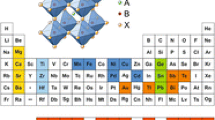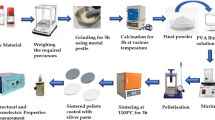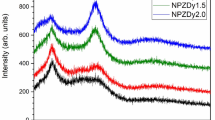Abstract
Glasses containing substantial amounts of well-dispersed luminescent Cu+ ions are attractive materials for applications in solid-state lighting, photonic waveguides, and solar cells. Thus far, coming across a simple yet effective method for the preparation of such has remained elusive given the instability of Cu+ relative to Cu2+, especially for syntheses carried out under the oxidizing air atmosphere. In this work, high concentrations of monovalent copper ions are shown to be successfully incorporated in a high-solubility phosphate glass matrix by a simple melt-quench method. The traditional Cu2+ spectrophotometric analysis commonly utilized for liquid solutions is proposed herein for the solid-state material to estimate the reduction efficiency of Cu2+ during the material preparation process. Reproducibly, the use of relatively large quantities of copper(II) oxide with equal amounts of reducing agent tin(II) oxide (up to 20 mol%), together with the use of sucrose to assist as antioxidant during melting in air atmosphere, yields high-reduction efficiencies estimated at 98 %. Along with the optical absorption analysis, photoluminescence spectroscopy is employed in evaluating the emission properties of the glasses in connection to the Cu+ ions. Further, solid-state 31P nuclear magnetic resonance spectroscopy reveals the structural features of the glasses that support the remarkable stabilization of the Cu+ ions.





Similar content being viewed by others
References
Simo A, Polte J, Pfänder N, Vainio U, Emmerling F, Rademann K (2012) Formation mechanism of silver nanoparticles stabilized in glassy matrices. J Am Chem Soc 134:18824–18833
El Hamzaoui H, Ouerdane Y, Bigot L, Bouwmans G, Capoen B, Boukenter A, Girard S, Bouazaoui M (2012) Sol–gel derived ionic copper-doped microstructured optical fiber: a potential selective ultraviolet radiation dosimeter. Opt Express 20:29751–29760
Kuznetsov AS, Tikhomirov VK, Shestakov MV, Moshchalkov VV (2013) Ag nanocluster functionalized glasses for efficient photonic conversion in light sources, solar cells and flexible screen monitors. Nanoscale 5:10065–10075
Debnath R, Das SK (1989) Site-dependent luminescence of Cu+ ions in silica glass. Chem Phys Lett 155:52–58
Boutinaud P, Parent C, Le Flem G, Pedrini C, Moine B (1992) Spectroscopic investigation of the copper(I)-rich phosphate CuZr2(PO4)3. J Phys Condens Matter 4:3031–3042
Parent C, Boutinaud P, Le Flem G, Moine B, Pedrini C, Garcia D, Faucher M (1994) Monovalent copper-activated oxygenated insulators. Opt Mater 4:107–113
Fujimoto Y, Nakatsuka M (1997) Spectroscopic properties and quantum yield of Cu-doped SiO2 glass. J Lumin 75:213–219
Ti Y, Qiu F, Cao Y, Jia L, Qin W, Zheng J, Farrell G (2008) Photoluminescence of copper ion exchange BK7 glass planar waveguides. J Mater Sci 43:7073–7078. doi:10.1007/s10853-008-3057-4
Gómez S, Urra I, Valiente R, Rodríguez F (2011) Spectroscopic study of Cu2+/Cu+ doubly and highly transmitting glasses for solar spectral transformation. Sol Energy Mater Sol Cells 95:2018–2022
Yasumori A, Tada F, Yanagida S, Kishi T (2012) Yellow photoluminescence properties of copper ion doped phase–separated glasses in alkali borosilicate system. J Electrochem Soc 159:J143–J147
Stepanov B, Ren J, Wagner T, Lorincik J, Frumar M, Churbanov M, Chigirinsky Y (2011) Solid state field-assisted diffusion of copper in multi-component tellurite glass. J Am Ceram Soc 94:1986–1988
Zhang Q, Chen G, Dong G, Zhang G, Liu X, Qiu J, Zhou Q, Chen Q, Chen D (2009) The reduction of Cu2+ to Cu+ and optical properties of Cu+ ions in Cu-doped and Cu/Al-codoped high silica glasses sintered in an air atmosphere. Chem Phys Lett 482:228–233
Liu H, Gan F (1986) Luminescence of Cu+ ions in phosphate glass. J Non-Cryst Solids 80:447–454
Boutinaud P, Duloisy E, Pedrini C, Moine B, Parent C, Le Flem G (1991) Fluorescence properties of Cu+ ion in phosphate glasses of the BaLiPO4–P2O5 system. J Solid State Chem 94:236–243
Murata T, Morinaga K (2000) Effect of antimony on the deposition and dispersion of metallic copper nanoparticles in phosphate glasses for optical nonlinear materials. Proc SPIE 4102:316–323
Uchida K, Kaneko S, Omi S, Hata C, Tanji H, Asahara Y, Ikushima AJ, Tokisaki T, Nakamura A (1994) Optical nonlinearities of a high concentration of small metal particles dispersed in glass: copper and silver particles. J Opt Soc Am B 11:1236–1243
Jiménez JA, Hockenbury JB (2013) Spectroscopic properties of CuO, SnO and Dy2O3 co-doped phosphate glass: from luminescent material to plasmonic nanocomposite. J Mater Sci 48:6921–6928. doi:10.1007/s10853-013-7497-0
Shyu JJ, Chiang CC (2011) Photoluminescence properties of Er3+-doped and Er3+/Yb3+ codoped SnO–P2O5 glasses. J Am Ceram Soc 94:2099–2103. doi:10.1111/j.1551-2916.2011.04489.x
Jiménez JA (2014) Optical properties of Cu nanocomposite glass obtained via CuO and SnO co-doping. Appl Phys A Mater Sci Process 114:1369–1376. doi:10.1007/s00339-013-7992-9
García MA, Borsella E, Paje SE, Llopis J, Villegas MA, Polloni R (2001) Luminescence time decay from Cu+ ions in sol–gel silica coatings. J Lumin 93:253–259
Borsella E, Dal Vecchio A, García MA, Sada C, Gonella F, Polloni R, Quaranta A, van Wilderen LJGW (2002) Copper doping of silicate glasses by the ion-exchange technique: a photoluminescence spectroscopy study. J Appl Phys 91:90–98
Brow RK (2000) Review: the structure of simple phosphate glasses. J Non-Cryst Solids 263–264:1–28
Koudelka L, Rösslerová I, Holubová J, Mošner P, Montagne L, Revel B (2011) Structural study of PbO–MoO3–P2O5 glasses by Raman and NMR spectroscopy. J Non-Cryst Solids 357:2816–2821
Valappil SP, Ready D, Abou Neel EA, Pickup DM, Chrzanowski W, O’Dell LA, Newport RJ, Smith MA, Wilson M, Knowles JC (2008) Antimicrobial gallium-doped phosphate-based glasses. Adv Funct Mater 18:732–741
Acknowledgements
The author thanks Dr. Chunqing Zhao, Manager of the Analytical Instrumentation Faculty in the Chemistry Department at UNF for the solid-state 31P NMR spectroscopy experiments.
Author information
Authors and Affiliations
Corresponding author
Rights and permissions
About this article
Cite this article
Jiménez, J.A. Efficient stabilization of Cu+ ions in phosphate glasses via reduction of Cu2+ by Sn2+ during ambient atmosphere melting. J Mater Sci 49, 4387–4393 (2014). https://doi.org/10.1007/s10853-014-8138-y
Received:
Accepted:
Published:
Issue Date:
DOI: https://doi.org/10.1007/s10853-014-8138-y




